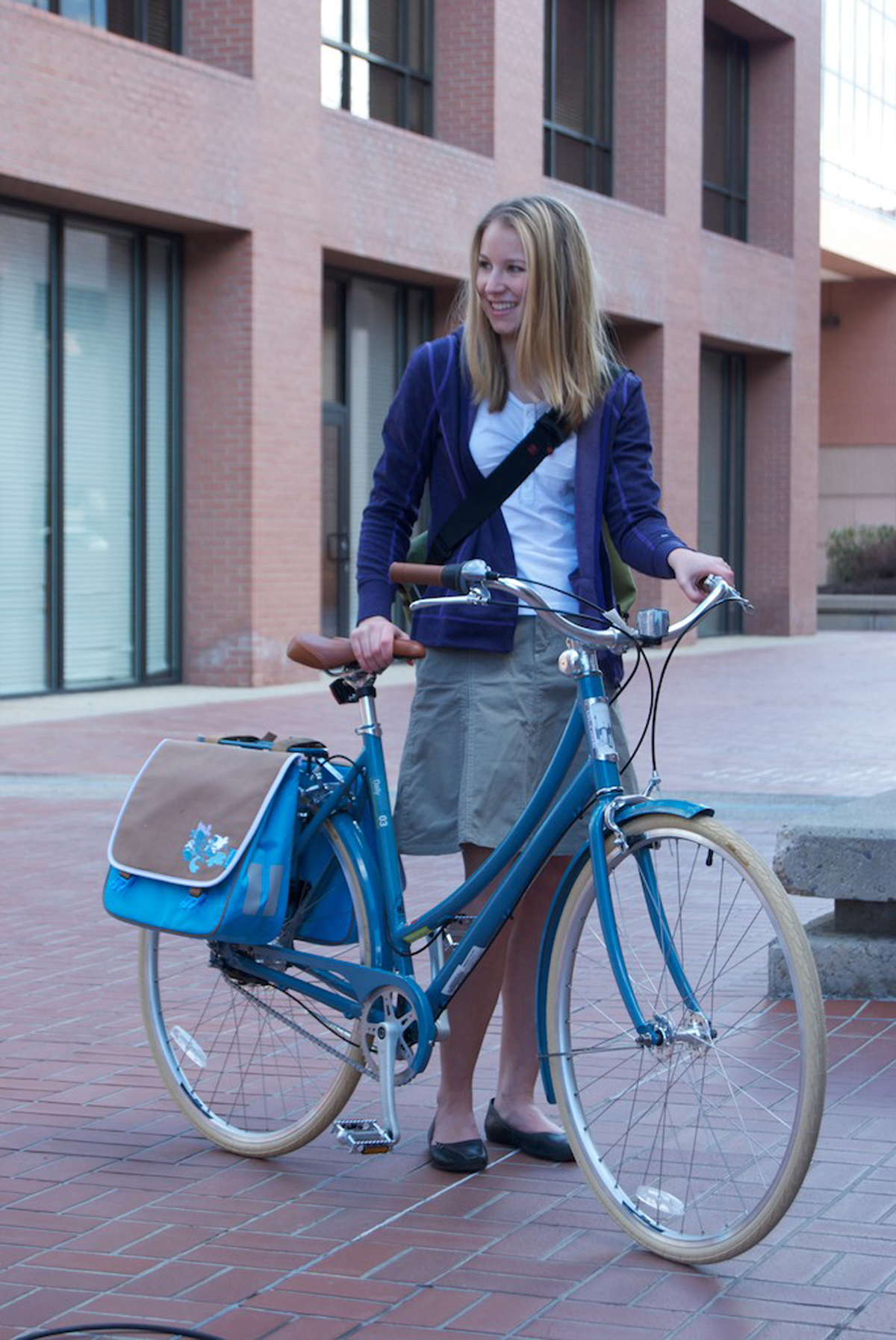By Tara McKee — In Europe, women lead the city biking movement and in many cities such as Copenhagen and Amsterdam, they clearly outnumber male riders. Fashion blogs such as Copenhagen Cycle Chic show how women in Denmark’s largest city dress for their commute, wearing dresses, suits, skirts, high heels and boots. Here in the states, big cities such as New York City have gone bicycle crazy, blending an eco-conscious style with the eco-conscious living. It’s chic to be seen riding a bike, so one might spot even models and movie stars riding their bikes around NYC or Beverly Hills.
The better the cycling infrastructure is in a community, the more likely women are to ride. Rocky Mountain states have made huge strides in the past few years, adding more miles of bicycle lanes and paths and widening road shoulders. More women are feeling more confident and ready to take the challenge of riding to work in Idaho’s Ada County or Wood River Valley as well as in Utah’s bike-friendly communities such as Salt Lake City and Provo. When communities strive to make the streets safer to ride on, they’ll find more cyclists taking to the streets dressed to impress, and not to duel with cars.
Want to take advantage of the greener and cheaper alternative to driving? During these fair weather days, it’s a great time to challenge yourself to give your gas-guzzling car a rest and make that commute to work by bicycle. Commuting needn’t be an ordeal, but you’ll want to assess the type of commute you have to make and choose the bicycle, clothing and accessories to make the ride an enjoyable one. If you’re headed to college, use your bicycle instead of a car to keep of the notorious “Freshmen 15” and save money at the same time. Whether your destination is work or school, you’ll want to learn the best places to keep your bicycle safe and secure. If you are comfortable locking it in the nearest bike rack, use a good quality u-lock. Many cities offer bicycle lockers for rent, as do some employers. Taking the bicycle right into your office may also be an alternative.
For tips on how to make a quick Wonder-Woman transformation from a biker into a credible executive, Cycling Utah will have a follow-up article on how to achieve a post-ride polish in next month’s issue.

City Style Commute
The Route: Relatively short (4 miles or less) trip that is mostly flat and has good bike lanes or low-speed traffic route the majority of the trip. Often, this is a completely urban route for women who can ride from their downtown loft or apartment to work or shopping within the downtown area.
The Bicycle: An upright, comfortable “city” bike with a step-through (women’s style) frame, fenders, chain guard, maybe even skirt guard. Dutch-style bicycles, which may be a bit heavy for a longer commute, are perfect for such a trip! Vintage bicycles with a step-through frame are also fun to ride. (Steel frames make for a softer ride.)
Extra accessories: Have your bicycle equipped with a bell, a be-seen light to make you visible on a gray, foggy day or in low-light conditions. A basket fitting on either the front or rear of the bicycle is an absolute necessity for many women. Buy a nice basket that appeals to your sense of style and is large enough to carry a purse, perhaps a small shopping bag and a few other items. If your bicycle has a rear rack, you may want to add some panniers to carry even more items. Thankfully, panniers have come a long way from just basic black and many sport beautiful prints and colors.
Clothing: The beauty of the step-through bicycles with chain guards and fenders is that a girl can wear a pretty dress and heels or fashionable boots and wide-leg pants without worrying about damaging them. Wedge heels are a little problematic for pedaling but some women find that a spike heel nicely fits around the pedal.
Special Tip: Give yourself time to enjoy a leisurely ride. Ride at a slow pace so you don’t break a sweat. The best route by bicycle won’t be the typical car route. You may be able to ride through parks, along a bicycle pedestrian path and straight onto that pathway at the end of the cul-de-sac. Get a local bikeways map or use the Google map bike app to plan out your route.

Suburban Commute
The Route: A mid-length trip (about 4-10 miles) that may involve a little hilly terrain. Remember, the best route by bike isn’t always the same for a car, you may wish to go a little farther out of your way to avoid high-speed traffic areas or significant hills.
The Bicycle: The categories of bicycles that are called “commuter” bicycles are perfect for this. But any upright, comfortable, somewhat lightweight bicycle will work. Women can find bikes in this category with a step-through frame so wearing a skirt, dress or longer coat is not a problem. To protect your clothing from the occasional spatter from the road add fenders. Many “commuter-style” bikes have a chain guard so you don’t have to worry about the chain catching on your pant leg or staining them with grease.
Extra Accessories for the bike: To carry what you need, add a rack with panniers (those baskets or bags that fit on the rear rack of your bike) and/or a front basket will nicely hold your purse, lunch, and other items you’ll want to pack. If your load is easily carried in a messenger bag, you could alternatively take that instead.
Clothing: On some days or some commutes, one can dress as she would for work. Alternatively, a loose-fitting comfortable top can be worn then changed for a nicer one once at your destination. Wear comfortable street shoes and casual skirt or pants.
To Pack: You may just want to change from tee shirt into a blouse once there, bring or have at work small make-up bag and hair accessories for touch-up. Bring heels to change into if desired. If you are carrying a laptop on your commute, you should probably carry it in a messenger bag rather than panniers to protect it from occasional jarring as you hit a few bumps in the road.
Long Distance Commute
The Route: –A longer route of well over 8 miles that may have some hills.
The Bicycle: –A lighter weight bicycle to get up the hills and cover the miles is preferable, such as a hybrid, a commuter-style bicycle or even a road bike.
Extra Accessories for the Bike: –Have a rack installed so you can carry some panniers, a basket if you like, and front and back lights for the low-light of early morning and evening commuting. If you have to keep your bike on a rack, get a good U-lock to keep it safe.
Clothing for the Commute: Wear what you are comfortable in for the distance. A mix of casual clothing and technical clothing might be a nice and practical choice. Technical tops work well to wick away moisture. Merino wool jerseys will do the same on cool autumn days. Remember, once you remove the clothing that you biked in, you are removing 90% of the sweat. Bike shoes aren’t necessary unless you prefer them.
To Pack or keep in your desk at work: A complete change of clothing including shoes, facial and/or baby wipes to wipe off sweat, a small make-up bag, a brush, comb and curling iron or flat iron as desired. A little spritz from a spray bottle of a combination of leave-in conditioner mixed with water can be used to alleviate the compliant of “helmet hair.” Dry shampoo also does wonders. If you are packing your clothes in the panniers, roll them instead of fold them to reduce the chance of them getting wrinkled.

Hybrid Commute
The Route: A long-distance commute made a lot easier by combining public transportation such as a bus or train or with your bike commute. This can include riding your bike to the terminal and locking it up on a rack or in a bike locker before getting on the public transportation or alternatively taking the bicycle with you; or even using a GreenBike in Salt Lake City to travel from the transit station to work and back. If the weather has suddenly turned bad or you have a hilly route home, use public transportation to make the homeward commute an easier one.
The Bicycle: It depends on the length of your bike commute, but a light bike that can be lifted onto the front rack of a bus with relative ease is practical. A folding bicycle may be more practical when there is no room on the train/bus for a bike.
Extra Accessories for the Bike or Commute: If you have a folding bike, you’ll want a messenger bag or backpack to carry what you need. Otherwise, have your bicycle equipped for the type of commute you have.
Clothing: Dress appropriate for the commute. If you have a folding bike, it will not likely have a chain guard, so wear an ankle band around your pant leg if necessary to keep it from catching in the chain.
Special Tip: It really isn’t difficult to get the bike onto a front-loading bike rack on a bus. To make it easier, the directions are literally spelled out on the stickers and first-timers would be surprised to find out how easy it is to put your bike on the bus and go! If you are taking your bike on the train, look for the specially marked train car which will be equipped for bike storage.

Campus Commuter
The Route: Usually the route is a relatively short ride from apartment, sorority, dormitory or house to college or university campus. It may involve a hill, perhaps two, but usually nothing significant.
The Bicycle: Choose a bike that is a nice fit for student budget; nothing flashy to attract thieves, but just comfortable and nice enough that you will enjoy riding it. A step-through frame is easier for getting on and off the bicycle when wearing a skirt. If you have an older mountain bike that you are making over as your get-around bike, change the knobby tires for “Slicks”—smooth tires that will make riding on the pavement easier, smoother and faster.
Accessories for the Bike or commute: Buy a bike with a chain guard if you want to be able to wear wide-leg pants or not worry about the occasional chain grease on your leg. A good-quality, strong lock is necessary to deter theft. A fixed flat basket, in which books can be strapped in, can help balance the load so it isn’t all on your back. A front basket needs to be difficult for thieves to easily take off.
Clothing: Dress in comfortable clothing appropriate for class and the weather. A light, easily packable windproof jacket is perfect for stashing when no longer needed.
To Pack: Books, school supplies, and a laptop. You may already have a backpack that carries these nicely, but if you get a sweaty back from the backpack, a messenger bag may be preferable. Keep a small make-up bag and brush or comb for touch-up as needed.








